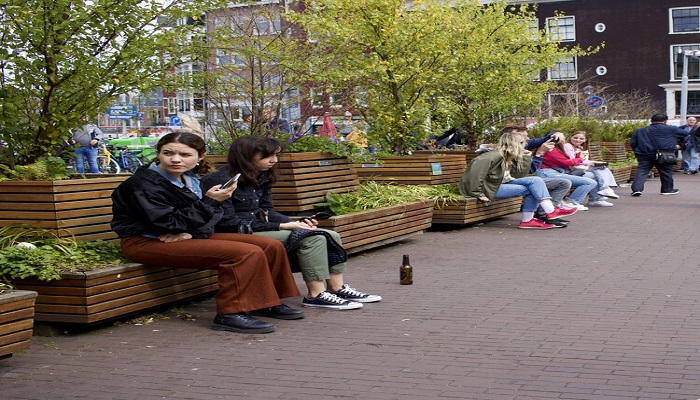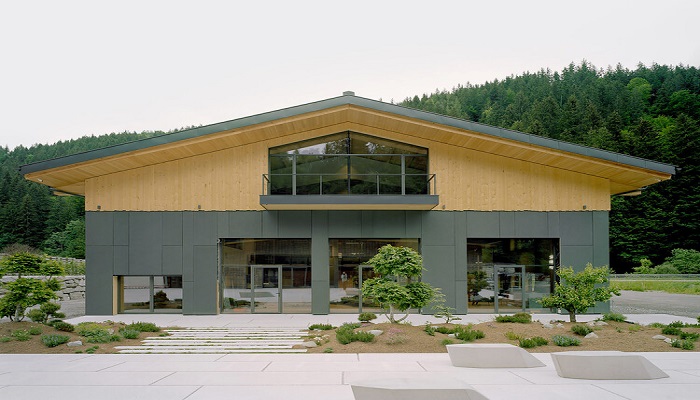HOK Advances Toward Carbon-Neutral Portfolio Ahead of AIA 2030 Commitment
In 2022, HOK’s projects achieved a 63.6% reduction in energy use intensity (EUI) compared to the baseline level, putting the firm on track to attain a carbon-neutral portfolio ahead of the 2030 deadline.
Over a decade ago, HOK was among the first design firms to join the American Institute of Architects’ (AIA) 2030 Commitment, which requires all new buildings and renovations to operate without fossil-fuel derived energy by 2030.
“What may have seemed like a daunting challenge in 2010 suddenly looks very achievable,” said Anica Landreneau, HOK’s director of sustainable design.
The AIA 2030 Commitment sets a challenging standard for design firms, particularly those like HOK that specialize in large-scale, complex projects such as hospitals, laboratories, airports, stadiums and major renovations. The EUI baseline level is derived from data provided by the U.S. Energy Information Administration’s Commercial Building Energy Consumption Survey and other energy benchmarking databases and industry data.
Last year, HOK’s projects achieved a 63.6% reduction in energy use intensity (EUI) compared to the baseline level, surpassing the AIA average of 50% and putting the firm on track to attain a carbon-neutral portfolio ahead of the 2030 deadline. The high-performance design translates to an avoidance of 85,369.5 metric tons (94,105 U.S. tons) of carbon dioxide emissions annually for each year these projects are in service.
Landreneau notes that HOK has consistently reduced energy use across its entire project carbon-neutral portfolio by focusing on building performance, without significantly relying on grid decarbonization, building electrification or renewable energy resources. By leveraging these rapidly emerging advancements in clean energy policy and technology, the firm is positioned to reach carbon neutrality before the 2030 target.
Additionally, HOK and other firms have broadened their commitment to carbon neutrality beyond the design phase, actively monitoring projects throughout the construction process. This more rigorous approach sets the bar even higher, ensuring that both design and construction practices adhere to the highest environmental standards.
Landreneau attributed HOK’s progress to a “relentless and comprehensive commitment to sustainability that is woven into every aspect of our practice. As a multidisciplinary design firm, we can address environmental issues in a holistic, integrative way, from energy efficiency and decarbonization to building material chemistry, regenerative design, and human health and equity.”
Landreneau also recognized the unwavering leadership of Bill Hellmuth, HOK’s former CEO, who passed away earlier this month. “I sat next to Bill in the D.C. studio, and he insisted that sustainable design couldn’t be mere lip service,” she said. “He constantly reminded us that sustainability was an integral part of our DNA and identity. I would often hear him pick up the phone and challenge our design leaders to do better. He envisioned HOK as an industry leader, setting an example for other firms to follow in addressing the climate crisis by delivering beautiful, resilient, climate-responsive design.”
Other Steps Toward Zero Carbon
As part of its commitment to addressing the full life cycle of its designs, HOK is pursuing several other strategies for achieving carbon neutrality in its work and operations. These include:
- The firm is actively tracking embodied carbon in about 25% of its projects, with a goal of reaching 100% within the next two years. A custom-developed Life Cycle Analysis Dashboard provides detailed data on embodied carbon use in each project, enabling design teams to monitor progress and identify areas for reducing the carbon footprint of future designs.
- Christine Vandover, a senior project designer in HOK’s New York studio, is advancing the interior design profession’s commitment to sustainability by collaborating with the International Interior Design Association (IIDA) and American Society of Interior Designers (ASID) to update their professional code of ethics to incorporate carbon reduction targets.
- HOK’s healthy and sustainable materials tracking program goes beyond the Lighting Power Density (LPD) reduction strategies that are key to achieving the energy reduction goals of the AIA 2030 Commitment. The firm’s product selection framework now considers embodied carbon, green chemistry, sustainable sourcing and circularity. Efforts to address the environmental impact of material choices include incorporating Environmental Product Declaration (EPD) requirements and Global Warming Potential (GWP) limits in steel and concrete specifications.
- HOK has pledged to meet enterprise-wide, science-based targets to reduce greenhouse gas (GHG) emissions in accordance with the Science Based Targets initiative (SBTi). The firm is gathering data and establishing ambitious targets for Scope 1 (direct emissions from HOK’s operations), Scope 2 (emissions from energy HOK consumes but is generated by others) and Scope 3 (emissions from all other activities outside HOK’s operations) emissions.
- HOK has committed to the American Society of Landscape Architects’ (ASLA) goals for achieving zero carbon emissions in projects by 2040. Alongside ASLA 2040 and AIA 2030, HOK has previously pledged to meet MEP 2040 and Structural Engineering (SE) 2050 targets for 100% emission reductions.
Landreneau is encouraged by the growing alignment between state, county and city building codes, performance standards and the design profession’s objectives to curb energy consumption. She also highlights the importance of meeting ambitious sustainability targets for business purposes. “Environmental, social and governance (ESG) data is increasingly vital for investors, lenders, insurers and government agencies. HOK’s commitment to sustainability serves as risk management for our clients,” she said.
“Our entire profession is recognizing the immense potential of technology and, more importantly, excellent design, to help,” added Landreneau. “HOK is uniquely positioned to influence every aspect of the built environment due to our interdisciplinary services and global reach. While we’re making great strides, we must continue to push ourselves, collaborate with groups like the AIA’s Large Firm Round Table and learn from other firms to support each other. Ultimately, we’re all in this together, and we won’t succeed in addressing the climate crisis unless we all excel. The world around us serves as a constant reminder. Fort Lauderdale recently experienced more than 25 inches of rain in 24 hours. We need all hands on deck, all the time. We can’t possibly do enough.”
Source: HOK



